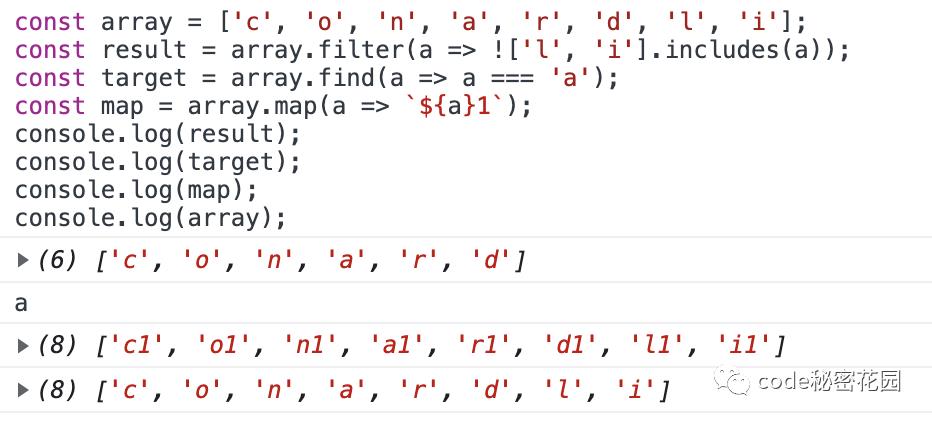JavaScript 数组新增 4 个非破坏性方法!
Posted 前端开发博客
tags:
篇首语:本文由小常识网(cha138.com)小编为大家整理,主要介绍了JavaScript 数组新增 4 个非破坏性方法!相关的知识,希望对你有一定的参考价值。
关注公众号 前端开发博客,领27本电子书
回复加群,自助秒进前端群
开门见山,javascript 数组即将新增 4 个新的非破坏性方法:
.toReversed()
.toSorted()
.toSpliced()
.with()
Change Array by copy 提案

这四个方法来源于新的 Change Array by copy 提案,目前已经处于 stage3阶段,意味着基本上不会再有太大变化了,我们即将在各大浏览器里看到它们的实现。
提案地址:https://github.com/tc39/proposal-change-array-by-copy
数组的破坏性和非破坏性
为啥这个提案叫 Change Array by copy 呢?字面意思就是从副本里改变数组。
这就要说起数组的破坏性和非破坏性方法了:
有些数组的方法我们在调用的时候不会改变原始的数组,我们称它们为非破坏性方法,比如我们经常用到的 filter、some、map、find 等方法,斗是不会改变原数组的:

但是,另外有一些方法是会改变原数组本身的,比如:sort、reverse、splice 等方法。

可以看到,原数组和排序后得到的新数组是一样的,说明这个方法改变了原数组。很多时候我们想用这些方法,但是又不想改变原数组,我们可能会先创建一个副本,比如下面这些操作:
const sorted1 = array1.slice().sort();
const sorted2 = [...array1].sort();
const sorted3 = Array.from(array1).sort();几个数组的新方法,就是用来解决这样的问题的。
toSorted()
.toSorted() 是 .sort() 的非破坏性版本:
const array = ['c', 'o', 'n', 'a', 'r', 'd', 'l', 'i'];
const result = array.toSorted();
console.log(result); // ['a', 'c', 'd', 'i', 'l', 'n', 'o', 'r']
console.log(array); // ['c', 'o', 'n', 'a', 'r', 'd', 'l', 'i']下面是个简单的 polyfill:
if (!Array.prototype.toSorted)
Array.prototype.toSorted = function (compareFn)
return this.slice().sort(compareFn);
;
toReversed()
.toReversed() 是 .reverse() 的非破坏性版本:
const array = ['c', 'o', 'n', 'a', 'r', 'd', 'l', 'i'];
const result = array.toReversed();
console.log(result); // ['i', 'l', 'd', 'r', 'a', 'n', 'o', 'c']
console.log(array); // ['c', 'o', 'n', 'a', 'r', 'd', 'l', 'i']下面是个简单的 polyfill:
if (!Array.prototype.toReversed)
Array.prototype.toReversed = function ()
return this.slice().reverse();
;
with()
with() 是对数组的某个元素赋值操作的非破坏性版本,比如下面的操作:
array[index] = value如果我们只是想得到一个新数组,又不想改变原数组,可以这样用:
const array = ['c', 'o', 'n', 'a', 'r', 'd', 'l', 'i'];
const result = array.with(0, 'ConardLi')
console.log(result); // ['ConardLi', 'o', 'n', 'a', 'r', 'd', 'l', 'i'];
console.log(array); // ['c', 'o', 'n', 'a', 'r', 'd', 'l', 'i']下面是个简单的 polyfill:
if (!Array.prototype.with)
Array.prototype.with = function (index, value)
const copy = this.slice();
copy[index] = value;
return copy;
;
toSpliced()
.splice(start, deleteCount, ...items) 方法比其他几个破坏性方法更复杂点:
它从 start 开始删除 deleteCount 个元素 ;
然后把 items 插入到被删除的位置;
最后返回已删除的元素。
const array = [1, 2, 3, 4, 5, 6];
const result = array.splice(1, 2, 0);
console.log(result); // [2, 3]
console.log(array); // [1, 0, 4, 5, 6].tospliced() 是 .splice() 的非破坏性版本,它会返回原数组变更后的版本,因此我们拿不到被删除的元素:
const array = [1, 2, 3, 4, 5, 6];
const result = array.tospliced(1, 2, 0);
console.log(result); // [1, 0, 4, 5, 6]
console.log(array); // [1, 2, 3, 4, 5, 6]下面是个简单的 polyfill:
if (!Array.prototype.toSpliced)
Array.prototype.toSpliced = function (start, deleteCount, ...items)
const copy = this.slice();
copy.splice(start, deleteCount, ...items);
return copy;
;
polyfill
提案目前还在 stage3阶段,在生产使用最好使用 polyfill:
https://github.com/tc39/proposal-change-array-by-copy/blob/main/polyfill.js
最后
我是小前端,欢迎大家围观我的朋友圈,搞搞技术,吹吹牛逼。我的微信:kujian89,秒添加,回复加群,可以进入 500人前端群。


关注公众号:前端开发博客
回复「小抄」,领取Vue、JavaScript 和 WebComponent 小抄 PDF
回复「Vue脑图」获取 Vue 相关脑图
回复「思维图」获取 JavaScript 相关思维图
回复「简历」获取简历制作建议
回复「简历模板」获取精选的简历模板
回复「加群」进入500人前端精英群
回复「电子书」下载我整理的大量前端资源,含面试、Vue实战项目、CSS和JavaScript电子书等。
回复「知识点」下载高清JavaScript知识点图谱
👍🏻 点赞 + 在看 支持小编
以上是关于JavaScript 数组新增 4 个非破坏性方法!的主要内容,如果未能解决你的问题,请参考以下文章